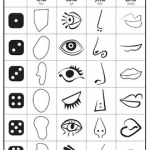Rolling a Picasso in Your Content
“Roll a Picasso” is an art game developed by Emily Glass for use in an art or art history classroom, but it it makes for a fun exercise for groups of any age. Each roll of a die relates to a printed key, directing the “artist” to draw the head, the left ear, the nose, the mouth, by copying the shape on the chart. The different combinations of the 24 shapes make for a high degree of variety in the finished product. It’s interesting that, just days after posting “Telling Your Business Story Through a Brand New Lens”, I was introduced to this visual proof of how, by creatively combining – and recombining – a finite number of elements, we can continue producing engaging marketing content.….,
In corporate content marketing training sessions, I teach that effective blog posts are centered around key themes, just like the recurring musical phrases that connect the different movements of a symphony. As you continue to write about your industry, your products, and your services, we tell business and practice owners, you’ll naturally find yourself repeating some key ideas – in fact, that’s exactly what you should be doing, we explain, to keep the content focused and targeted while still offering variety.
 It’s important to stress that blog and social media posts tend to be most effective when they focus on just one idea. A content writer might go about:
It’s important to stress that blog and social media posts tend to be most effective when they focus on just one idea. A content writer might go about:
– busting one myth common among consumers of their product or service they’re marketing
– offering one testimonial from a user of that product or service
– describing an unusual application for a product
– describing one common problem their service helps solve
– updating readers on one new development in that industry or profession
– offering a unique opinion or slant on best practices
Each post is similar to one “roll of the dice”, with the long-term effect being your “Picasso” work of art!






Follow us online!